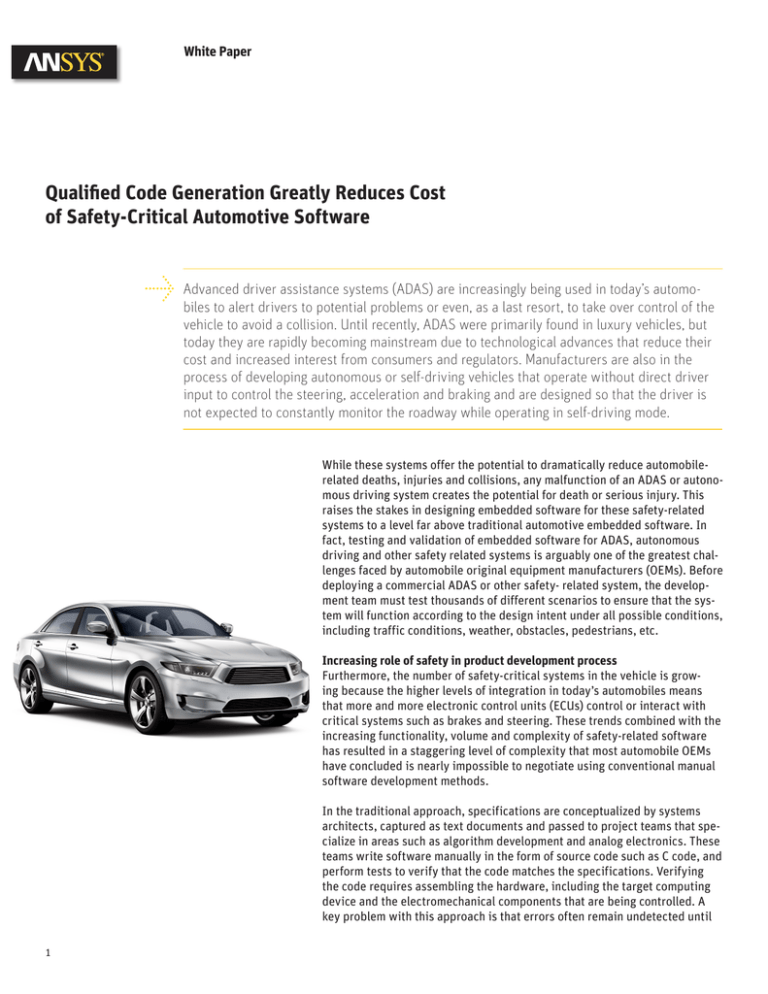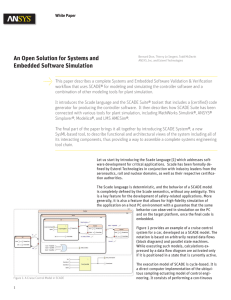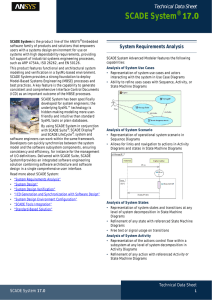
White Paper
Qualified Code Generation Greatly Reduces Cost
of Safety-Critical Automotive Software
Advanced driver assistance systems (ADAS) are increasingly being used in today’s automobiles to alert drivers to potential problems or even, as a last resort, to take over control of the
vehicle to avoid a collision. Until recently, ADAS were primarily found in luxury vehicles, but
today they are rapidly becoming mainstream due to technological advances that reduce their
cost and increased interest from consumers and regulators. Manufacturers are also in the
process of developing autonomous or self-driving vehicles that operate without direct driver
input to control the steering, acceleration and braking and are designed so that the driver is
not expected to constantly monitor the roadway while operating in self-driving mode.
While these systems offer the potential to dramatically reduce automobilerelated deaths, injuries and collisions, any malfunction of an ADAS or autonomous driving system creates the potential for death or serious injury. This
raises the stakes in designing embedded software for these safety-related
systems to a level far above traditional automotive embedded software. In
fact, testing and validation of embedded software for ADAS, autonomous
driving and other safety related systems is arguably one of the greatest challenges faced by automobile original equipment manufacturers (OEMs). Before
deploying a commercial ADAS or other safety- related system, the development team must test thousands of different scenarios to ensure that the system will function according to the design intent under all possible conditions,
including traffic conditions, weather, obstacles, pedestrians, etc.
Increasing role of safety in product development process
Furthermore, the number of safety-critical systems in the vehicle is growing because the higher levels of integration in today’s automobiles means
that more and more electronic control units (ECUs) control or interact with
critical systems such as brakes and steering. These trends combined with the
increasing functionality, volume and complexity of safety-related software
has resulted in a staggering level of complexity that most automobile OEMs
have concluded is nearly impossible to negotiate using conventional manual
software development methods.
In the traditional approach, specifications are conceptualized by systems
architects, captured as text documents and passed to project teams that specialize in areas such as algorithm development and analog electronics. These
teams write software manually in the form of source code such as C code, and
perform tests to verify that the code matches the specifications. Verifying
the code requires assembling the hardware, including the target computing
device and the electromechanical components that are being controlled. A
key problem with this approach is that errors often remain undetected until
1
Qualified Code Generation Greatly Reduces
Cost of Safety-Critical Automotive Software
all the modules can be tested together at the prototype stage. Because the
cost of fixing a problem generally increases by an order of magnitude as the
design progresses, late-stage problems quickly drive up development costs.
As the size and complexity of automotive safety-critical systems continues
to grow, the cost, time and risk involved in manually producing, testing and
verifying automotive embedded software have increased exponentially.
Moving to a model-based design process
Many automotive OEMs have addressed these difficulties by changing to a
model-based design process in which a graphical model of the embedded
software and systems becomes the cornerstone of the development process.
Engineers can simulate the behavior of the model on a PC workstation and
immediately view the results, making it possible to gain critical insights early
in the systems design process and to rapidly improve the model’s performance. Engineers also can link the model’s predicted behavior to specific
customer requirements. Finally, the model can be used to automatically
generate the embedded code, thus eliminating the need for manual coding.
Compliance with safety-related standards enables automobile OEMs and
their suppliers to demonstrate that they use consistent, auditable processes
for designing safety-related systems. ISO 26262, the safety standard that
applies to embedded systems and software for automotive applications, is
now the state-of-the-art for developing automotive active and passive safety
systems including ADAS, autonomous driving, vehicle dynamics, braking,
steering, powertrain controls, etc. Current processes for development of
embedded software for automotive safety-related applications are being
updated to achieve ISO 26262 compliance.
ISO 26262 includes the definition of an automotive safety lifecycle, identifying the risk of elements based on Automotive Safety Integrity Levels (ASILs)
from A (lowest) to D (highest). Situation analysis and hazard identification
are performed in order to identify the potential unintended behaviors of the
item that could lead to a hazardous event. Part 6 of ISO 26262 describes
the requirements for product development at the software level including
requirements, architectural design, unit design and implementation, unit and
integration testing.
Need for an ISO 26262 qualified code generator
A limiting factor in the use of existing model-based design environments in
the development of safety-related automotive embedded code is that the
code generator used in today’s leading model-based design environment
has not been developed in compliance with any safety standard such as ISO
26262, which means that companies following an ISO 26262-compliant
process are not allowed to trust its output. The code requires an extensive
manual verification and validation process which negates one of the core advantages of the model-based design concept. Typically, each model-to-code
translation triggers back-to-back review and testing phases to verify that the
executable compiled from the generated code matches the model used in the
design process. Some parts of this testing process, such as demonstrating
2
Qualified Code Generation Greatly Reduces
Cost of Safety-Critical Automotive Software
numerical equivalence, can be automated. But other required elements of the
testing process such as demonstrating traceability of software safety requirements, software development artifacts and test cases are much more difficult
to automate.
Emergence of first qualified code generator
The recent qualification of the ANSYS SCADE Suite code generator for developing ISO 26262 compliant applications up to ASIL D, the highest safety requirement for automotive applications, substantially reduces the embedded
software development time and cost. The code generator is offered as part of
a complete end-to-end, model-based systems engineering (MBSE) solution
for the development of safety-related systems. It has been proven through
its use in the development of many safety-critical aeronautics systems by
Airbus, Boeing, Pratt & Whitney, General Electric and many others.
The system and embedded software lifecycle V-cycle defined in
ISO 26262
Software arhitectural design with SCADE System
3
The SCADE Suite KCG code generator was qualified at TCL3 by TÜV SÜD to
be used to develop ASIL D automotive software. To achieve its qualification,
KCG was developed according to the IEC 61508 standard. As part of this process, hazard analysis and risk assessment were performed on the KCG tool
using HAZOP, a method recommended by ISO 26262. This analysis produced
deviations, potential causes and mitigation actions from all tool stakeholders
including the tool developer, tool installer and tool users. Dozens of failure
conditions were identified and dozens of individual mitigation actions were
allocated to the tool developer, tool installer and tool user. The developer
actions were achieved by verification activities performed during the development cycle of the code generator, such as design and code reviews and
structural coverage analysis. As a result, costly code reviews and low-level
testing activities are not required to verify that the code is a correct implementation of the model. The SCADE Suite code generator has already been
used to produce embedded software without the need for manual verification
for many safety-critical projects, including many commercial airliners flying
today produced by Airbus, Boeing and Embraer and other leading airframe
manufacturers.
The SCADE KCG code generator is offered as part of a complete toolset that
enables efficient implementation of the lifecycle V-model defined in ISO
26262 Part 6. The SCADE System tool is used to describe the system and
software architecture, using SysML block diagrams to represent software
architecture components and connect them through ports and connectors.
The next step is to produce a software architectural design that implements
the requirements using software blocks. Then software engineers model
the software components associated with the software architecture, often
using state machines and data flows to model the logic and control laws. The
SCADE LifeCycle tool is used during this phase to establish traceability links
from the initial system requirements to the design models, generated code
and test scenarios.
Qualified Code Generation Greatly Reduces
Cost of Safety-Critical Automotive Software
The model is simulated to detect functional faults early in the design process. Test cases can be run and validated in the host environment long before
they are run in the more expensive and complicated target hardware environment. Tools are provided to automate the creation and management of test
cases and to analyze test coverage to ensure that the design fully complies
with its software requirements. SCADE Test Environment for Host has been
qualified as a verification tool for DO-178C/DO-330, so the results prove the
compliance of a SCADE model with its high level requirements (HLRs). The
same functional test execution is provided on host and targets independent
of code generation.
Software arhitectural design with SCADE System
Suburu uses qualilfied code generator to develop HEV control software
Subaru®, the automotive brand of Fuji Heavy Industries (FHI) Ltd. — a comprehensive, multifaceted transport equipment manufacturer — recently started its own HEV and electric vehicle (EV) programs and adopted the modelbased design approach for upcoming development projects, like the Subaru
XV. Engineers used the SCADE System to develop the software architecture
from the ground up. The software development process began with the development of test scenarios based on software requirements and the conversion
of many pieces of functional Simulink® models designed by system engineers
into SCADE models via a gateway. Functional models were verified by unit
testing. The final stage of the process was to generate C source code from the
verified models using the ISO 26262 qualified SCADE Suite KCG code generator. The verification time at code level was substantially reduced since most
of the verification was completed upfront at the model level.
Conclusion
As automobile electronics become more prevalent and sophisticated, ensuring the reliability of the embedded software code within those systems
becomes critical to the safety of passengers and pedestrians. The development of an ISO 26262 qualified code generator helps automotive OEMs and
suppliers drastically reduce development costs while ensuring that their
embedded software applications will meet stringent safety standards. This
code generator is part of a model-based design solution in which modeling
and simulation are used throughout the product development lifecycle as the
authoritative definition and verification of the product design.
ANSYS, Inc.
Southpointe
2600 ANSYS Drive
Canonsburg, PA 15317
U.S.A.
724.746.3304
ansysinfo@ansys.com
If you’ve ever seen a rocket launch, flown on an airplane, driven a car, used
a computer, touched a mobile device, crossed a bridge or put on wearable
technology, chances are you’ve used a product where ANSYS software played a
critical role in its creation. ANSYS is the global leader in engineering simulation.
We help the world’s most innovative companies deliver radically better products
to their customers. By offering the best and broadest portfolio of engineering
simulation software, we help them solve the most complex design challenges
and engineer products limited only by imagination.
Visit www.ansys.com for more information.
© 2016 ANSYS, Inc. All Rights Reserved.
Any and all ANSYS, Inc. brand, product, service and feature names, logos and slogans are registered
trademarks or trademarks of ANSYS, Inc. or its subsidiaries in the United States or other countries. All
other brand, product, service and feature names or trademarks are the property of their respective owners.



